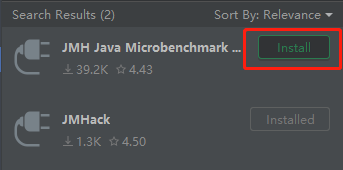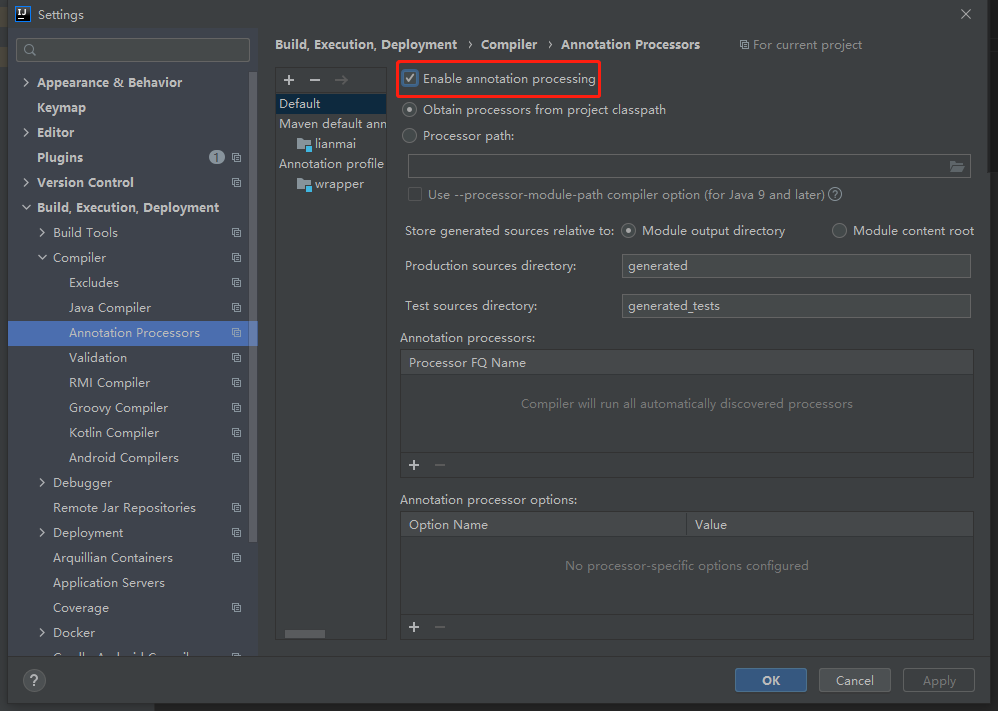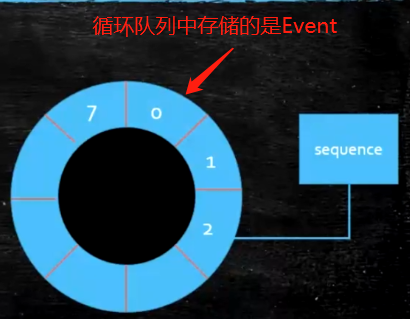JMH和Disrupter
JMH(Java Microbenchmark Harness)#
官方地址:http://openjdk.java.net/projects/code-tools/jmh/
添加依赖,官方地址:https://mvnrepository.com/artifact/org.openjdk.jmh/jmh-core
<!-- https://mvnrepository.com/artifact/org.openjdk.jmh/jmh-core --> <dependency> <groupId>org.openjdk.jmh</groupId> <artifactId>jmh-core</artifactId> <version>1.21</version> </dependency>
添加依赖,官方地址:https://mvnrepository.com/artifact/org.openjdk.jmh/jmh-generator-annprocess
<!-- https://mvnrepository.com/artifact/org.openjdk.jmh/jmh-generator-annprocess --> <dependency> <groupId>org.openjdk.jmh</groupId> <artifactId>jmh-generator-annprocess</artifactId> <version>1.21</version> <scope>test</scope> </dependency>
IDEA安装JMH插件和配置#
允许JMH对注解进行处理#
添加注解测试#
public class Test{ @Benchmark @Warmup(iterations = 1, time = 3) @Fork(5) @BenchmarkMode(Mode.Throughput) @Measurement(Iterations = 1, time = 3) public void testCode(){ // coding } }
- benchmark
指定测试哪段代码
- warmup
预热,由于JVM中对于特定代码会存在优化(本地化),预热对于测试结果很重要
- fork
指定线程数
- benchmarkmode
基准测试的模式
- measurement
总共执行多少次
Disruptor#
官方地址:http://lmax-exchange.github.io/disruptor/
github地址:https://github.com/LMAX-Exchange/disruptor
特点#
对比ConcurrentLinkedQueue #
- 链表实现
JDK中没有ConcurrentArrayQueue
Disruptor是数组实现的#
- 无锁,高并发,使用环形Buffer,直接覆盖(不用清除)旧的数据,降低GC频率
- 实现了基于事件的生产者消费者模式(观察者模式)
RingBuffer#
- 环形队列
- RingBuffer的序号,指向下一个可用的元素
采用数组实现,没有首尾指针#
对比ConcurrentLinkedQueue,用数组实现的速度更快
假如长度为8,当添加到第12个元素的时候在哪个序号上呢?用12%8决定
当Buffer被填满的时候到底是覆盖还是等待,由Producer决定
长度设为2的n次幂,利于二进制计算,例如:12%8 = 12 & (8 - 1) pos = num & (size -1)
Disruptor开发步骤#
定义Event - 队列中需要处理的元素#
定义Event工厂,用于填充队列#
- 效率:disruptor初始化的时候,会调用Event工厂,对ringBuffer进行内存的提前分配
- GC频率会降低
定义EventHandler(消费者),处理容器中的元素#
事件发布模板
long sequence = ringBuffer.next(); // Grab the next sequence try { LongEvent event = ringBuffer.get(sequence); // Get the entry in the Disruptor // for the sequence event.set(8888L); // Fill with data } finally { ringBuffer.publish(sequence); }
使用EventTranslator发布事件#
EventTranslator<LongEvent> translator1 = new EventTranslator<LongEvent>() { @Override public void translateTo(LongEvent event, long sequence) { event.set(8888L); } }; ringBuffer.publishEvent(translator1); //=============================================================== EventTranslatorOneArg<LongEvent, Long> translator2 = new EventTranslatorOneArg<LongEvent, Long>() { @Override public void translateTo(LongEvent event, long sequence, Long l) { event.set(l); } }; ringBuffer.publishEvent(translator2, 7777L); //=============================================================== EventTranslatorTwoArg<LongEvent, Long, Long> translator3 = new EventTranslatorTwoArg<LongEvent, Long, Long>() { @Override public void translateTo(LongEvent event, long sequence, Long l1, Long l2) { event.set(l1 + l2); } }; ringBuffer.publishEvent(translator3, 10000L, 10000L); //=============================================================== EventTranslatorThreeArg<LongEvent, Long, Long, Long> translator4 = new EventTranslatorThreeArg<LongEvent, Long, Long, Long>() { @Override public void translateTo(LongEvent event, long sequence, Long l1, Long l2, Long l3) { event.set(l1 + l2 + l3); } }; ringBuffer.publishEvent(translator4, 10000L, 10000L, 1000L); //=============================================================== EventTranslatorVararg<LongEvent> translator5 = new EventTranslatorVararg<LongEvent>() { @Override public void translateTo(LongEvent event, long sequence, Object... objects) { long result = 0; for(Object o : objects) { long l = (Long)o; result += l; } event.set(result); } }; ringBuffer.publishEvent(translator5, 10000L, 10000L, 10000L, 10000L);
使用Lamda表达式#
package com.test.disruptor; import com.lmax.disruptor.RingBuffer; import com.lmax.disruptor.dsl.Disruptor; import com.lmax.disruptor.util.DaemonThreadFactory; public class Main03 { public static void main(String[] args) throws Exception { // Specify the size of the ring buffer, must be power of 2. int bufferSize = 1024; // Construct the Disruptor Disruptor<LongEvent> disruptor = new Disruptor<>(LongEvent::new, bufferSize, DaemonThreadFactory.INSTANCE); // Connect the handler disruptor.handleEventsWith((event, sequence, endOfBatch) -> System.out.println("Event: " + event)); // Start the Disruptor, starts all threads running disruptor.start(); // Get the ring buffer from the Disruptor to be used for publishing. RingBuffer<LongEvent> ringBuffer = disruptor.getRingBuffer(); ringBuffer.publishEvent((event, sequence) -> event.set(10000L)); System.in.read(); } }
ProducerType生产者线程模式#
ProducerType有两种模式
- Producer.MULTI,默认,表示在多线程模式下产生sequence
- Producer.SINGLE
如果确认是单线程生产者,那么可以指定SINGLE,效率会提升
如果是多个生产者(多线程),但模式指定为SINGLE,会出问题
等待策略#
- BlockingWaitStrategy:通过线程阻塞的方式,等待生产者唤醒,被唤醒后,再循环检查依赖的sequence是否已经消费
- BusySpinWaitStrategy:线程一直自旋等待,可能比较耗cpu
- LiteBlockingWaitStrategy:线程阻塞等待生产者唤醒,与BlockingWaitStrategy相比,区别在signalNeeded.getAndSet
- 如果两个线程同时访问,一个访问waitfor,一个访问signalAll时,可以减少lock加锁次数
- LiteTimeoutBlockingWaitStrategy:与LiteBlockingWaitStrategy相比,设置了阻塞时间,超过时间后抛异常
- PhasedBackoffWaitStrategy:根据时间参数和传入的等待策略来决定使用哪种等待策略
- TimeoutBlockingWaitStrategy:相对于BlockingWaitStrategy来说,设置了等待时间,超过后抛异常
- YieldingWaitStrategy:尝试100次,然后Thread.yield()让出cpu
- SleepingWaitStrategy:sleep
消费者异常处理#
- 默认,disruptor.setDefaultExceptionHandler()
- 覆盖,disruptor.handleExceptionFor().with()
作者:BigBender
出处:https://www.cnblogs.com/BigBender/p/14441185.html
版权:本作品采用「署名-非商业性使用-相同方式共享 4.0 国际」许可协议进行许可。








【推荐】国内首个AI IDE,深度理解中文开发场景,立即下载体验Trae
【推荐】编程新体验,更懂你的AI,立即体验豆包MarsCode编程助手
【推荐】抖音旗下AI助手豆包,你的智能百科全书,全免费不限次数
【推荐】轻量又高性能的 SSH 工具 IShell:AI 加持,快人一步
· Linux系列:如何用heaptrack跟踪.NET程序的非托管内存泄露
· 开发者必知的日志记录最佳实践
· SQL Server 2025 AI相关能力初探
· Linux系列:如何用 C#调用 C方法造成内存泄露
· AI与.NET技术实操系列(二):开始使用ML.NET
· 被坑几百块钱后,我竟然真的恢复了删除的微信聊天记录!
· 没有Manus邀请码?试试免邀请码的MGX或者开源的OpenManus吧
· 【自荐】一款简洁、开源的在线白板工具 Drawnix
· 园子的第一款AI主题卫衣上架——"HELLO! HOW CAN I ASSIST YOU TODAY
· Docker 太简单,K8s 太复杂?w7panel 让容器管理更轻松!